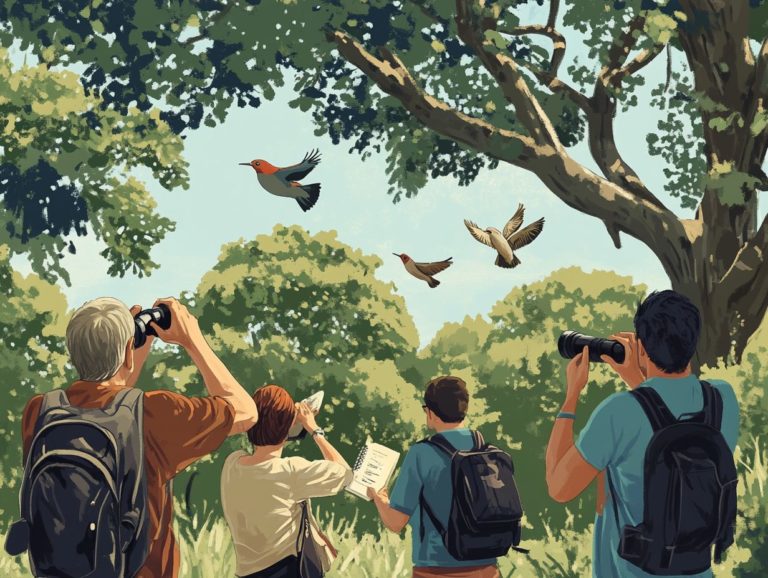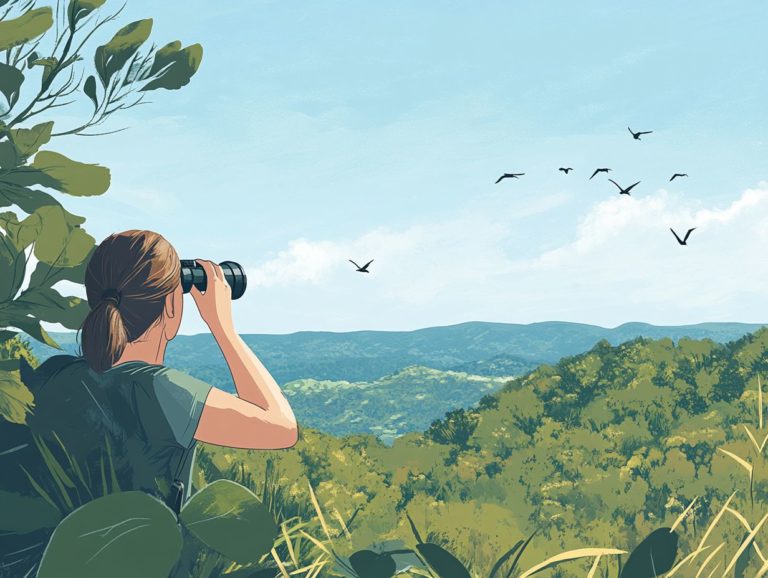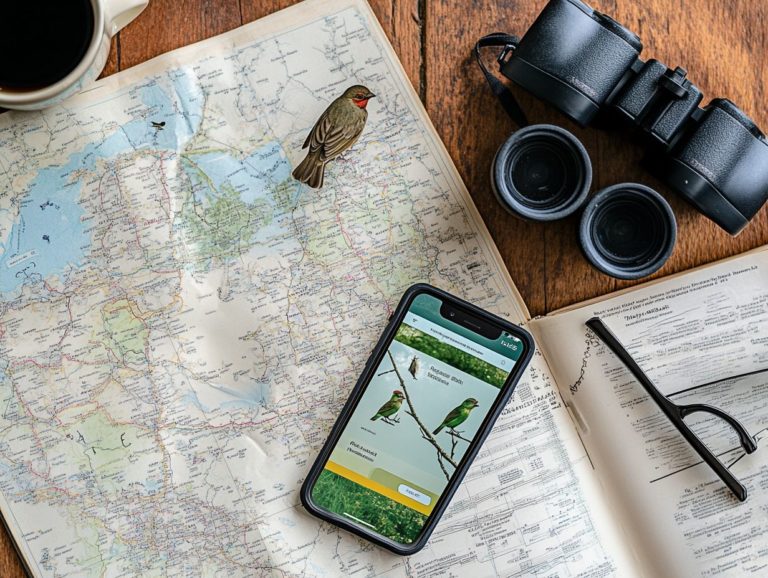10 Bird Watching Habits You Should Develop
Bird watching is more than just a hobby; it’s a way to appreciate nature and understand wildlife. Whether you are a novice or an experienced birder, cultivating specific habits can enhance your bird-watching experience and deepen your connection with the avian world. Join us now to boost your bird-watching skills and truly connect with nature!
This article also covers the benefits of bird watching, tools you might need, great places to go, and seasonal tips. Let’s dive into ten game-changing habits that will elevate your bird-watching skills!
Contents
- Key Takeaways:
- 1. Keep a Birding Journal
- 2. Learn Bird Calls and Songs
- 3. Use Binoculars and Field Guides
- 4. Join Local Birdwatching Groups
- 5. Visit Different Habitats
- 6. Observe Birds’ Behavior
- 7. Take Part in Citizen Science Projects
- 8. Keep Track of Your Sightings
- 9. Be Respectful of Birds and Their Habitat
- 10. Share Your Knowledge with Others
- What Are the Benefits of Bird Watching?
- How Can Bird Watching Be Enjoyed in Different Seasons?
- What Are the Best Locations for Bird Watching?
- Frequently Asked Questions
- 1. What are the top 10 bird watching habits I should develop?
- 2. How can keeping a journal improve my bird watching experience?
- 3. Why is it important to get to know local bird species?
- 4. How do binoculars enhance the bird watching experience?
- 5. What does it mean to practice ethical birding?
- 6. How can participating in citizen science projects benefit bird watching?
Key Takeaways:
- Record sightings: Keep track of everything you see.
- Learn calls: Identify birds by their sounds.
- Invest in tools: Binoculars and guides make bird-watching easier and more fun.
1. Keep a Birding Journal
Keeping a birding journal offers numerous benefits, including the ability to record bird sightings and personal observations about various species encountered during birding trips.
By documenting these details in a birding log, enthusiasts can enhance their observation skills and track their progress in bird identification.
This practice fosters a deeper appreciation for nature and sharpens one’s ability to recognize different species and their unique behaviors.
Effective note-taking can be achieved through structured entries that include the bird species observed, locations, and specific behaviors that may indicate feeding or social habits, along with the dates and weather conditions.
Over time, maintaining a journal improves individual identification skills and uncovers significant behavioral patterns.
2. Learn Bird Calls and Songs
Learning to recognize bird calls and songs is a fascinating aspect of birdwatching; it is also a vital skill for effective bird identification. This ability allows birdwatchers to identify birds even when they are out of sight.
Recognizing these melodic phrases enhances enthusiasts’ appreciation for the diversity of avian life in their surroundings. The Audubon Bird Guide is an invaluable resource, providing detailed information about various species and their vocalizations.
To improve their auditory identification skills, birdwatchers should complement their listening efforts with visual observations, such as noting the habitat where the calls are heard.
Techniques like recording calls or joining local birding groups can further enrich this practice, fostering a deeper connection to nature and its winged inhabitants.
3. Use Binoculars and Field Guides
High-quality binoculars and comprehensive field guides are essential tools for serious bird watchers. They facilitate bird identification and allow for closer visual observations of various species in their natural habitats.
When selecting binoculars, choose lightweight models that are easy to hold for long periods. Look for features like waterproofing and clear lenses for a better bird-watching experience.
Popular field guides can also aid in learning about the avifauna of different regions. Resources like the National Geographic Field Guide and The Sibley Guide to Birds provide excellent visual aids for identification.
Additionally, birding apps such as Merlin Bird ID and BirdLog help enthusiasts quickly identify species and keep track of sightings, making the bird-watching experience easier and more enjoyable.
4. Join Local Birdwatching Groups
Joining local birdwatching organizations can greatly enhance your birding knowledge while connecting you with fellow bird enthusiasts. This leads to more shared time outdoors, enriching experiences in nature, and learning about different types of birds together.
These organizations often arrange group birding trips. This makes the activity more enjoyable and offers opportunities to explore different environments where a wider variety of birds can be observed. Guided walks led by experienced bird watchers teach participants about bird behaviors and calls. This helps novice birders build confidence and develop their skills.
Being part of a birdwatching community grants access to valuable resources, such as mentorship, conservation efforts, and educational opportunities. This supports the growth of the hobby for everyone, from beginners to seasoned watchers. Community involvement transforms a solitary pursuit into a collaborative experience, enhancing the enjoyment of the natural world.
5. Visit Different Habitats
Experiencing a variety of bird habitats is essential for learning about the many bird species that occupy specific environments and for observing intriguing migration patterns during seasonal changes. This significantly enhances the overall birdwatching experience.
Different environments, such as wetlands, forests, and urban parks, offer unique opportunities for birdwatchers to see a wide range of birds. For instance, wetlands are abundant in waterfowl and shorebirds, with the Everglades in Florida serving as a prime birding destination. Forested areas, like the Great Smoky Mountains, provide habitats for songbirds and raptors. Urban parks and gardens can attract fascinating species seeking refuge from the clamor of city life.
To enhance your birdwatching, it’s important to adapt techniques to the specific environment. For example, remaining quiet and using binoculars in forests can help observers spot shy and camouflaged species. A more relaxed approach in urban parks can draw in curious local birds.
6. Observe Birds’ Behavior
Watching how birds behave can make your birdwatching even more exciting! It offers valuable insights into their social structures, feeding habits, and mating rituals. This allows birdwatchers to appreciate the nuances of various species in their natural settings.
To achieve this, employing techniques such as patience and stealth is essential. By remaining quiet and still, observers can gain a deeper understanding of how these creatures interact with one another and their environment.
Noting subtle movements and vocalizations can further enrich your understanding of bird habits. For instance, regularly documenting specific behaviors observed during different seasons can reveal patterns that might otherwise go unnoticed, fostering a deeper respect for the complexity of avian life.
7. Take Part in Citizen Science Projects
Citizen science initiatives, such as eBird, enable bird watchers to engage in wildlife conservation. You can track bird sightings and distributions, thereby providing valuable data for researchers. Join the effort to protect our feathered friends!
Each initiative has varying requirements, ranging from counting the number of birds during migration seasons to reporting observations of nesting or feeding behavior. This creates a treasure trove of data on species distribution, population numbers, and behaviors within their habitats.
Participation in these projects can significantly enhance the birding experience by fostering camaraderie among bird watchers. It also contributes to broader conservation efforts aimed at protecting fragile ecosystems and promoting biodiversity.
8. Keep Track of Your Sightings
Log your bird sightings to sharpen your identification skills. It creates a personal record that helps track your progress.
You can use traditional notebooks for personal sketches and reflections. Alternatively, birding apps offer efficient tracking features like geolocation, which shows your exact location on a map.
It’s vital to record the date, time, location, weather conditions, and behavioral observations. These details enrich your birdwatching experience.
9. Be Respectful of Birds and Their Habitat
Respecting birds and their habitats is essential for ethical birding. This commitment reduces human impact on wildlife.
Avoid nesting sites and feeding areas during critical times like mating seasons. Observing from a safe distance protects their territories.
Follow the “Leave No Trace” principles. Pack out what you pack in and stick to designated trails to prevent habitat damage.
Appreciating the beauty of birds while ensuring their safety enhances the experience for everyone involved.
Sharing your birding knowledge boosts your understanding and inspires others. It cultivates a community passionate about nature and wildlife.
Join workshops to exchange ideas and learn from fellow birdwatchers. Guided trips let you observe species and gain tips from seasoned birders.
Writing articles allows you to share unique perspectives with a wider audience. Teaching newcomers is crucial for sparking their curiosity and guiding their learning.
These activities create a rich learning environment that benefits everyone.
What Are the Benefits of Bird Watching?
Bird watching offers many benefits, from personal well-being to deeper connections with nature. Here are some key advantages:
- Relaxation and Stress Reduction: Bird watching helps you step away from daily life. This hobby promotes relaxation and brings peace.
- Focus and Mindfulness: It encourages concentration, often described as meditative. Observing birds demands focus, making it great mental exercise.
- Improved Awareness: This activity boosts your awareness of nature. Learning about bird species deepens your understanding of biodiversity.
- Appreciation for Nature: The unique beauty of birds inspires a love for the environment. Many feel compelled to protect this beauty for future generations.
- Sense of Adventure: Bird watching can be an exciting adventure, offering travel opportunities near and far.
- Conservation: It fosters a connection to wildlife conservation. Many bird watchers advocate for protecting the habitats of the birds they love.
How Can Bird Watching Help with Conservation Efforts?
Bird watching contributes to conservation efforts by raising awareness about the importance of preserving wildlife habitats.
It also provides valuable data through citizen science projects that track migration and population trends.
This engaging activity encourages individuals to get involved in various conservation initiatives, such as monitoring local species for breeding success and participating in annual bird counts.
These observations serve as critical snapshots of biodiversity, enabling researchers to identify changes in populations and habitats.
For instance, some data collected by bird watchers have been utilized to inform targeted conservation actions, such as habitat restoration and the protection of essential breeding grounds.
The community aspect of birding fosters a sense of shared responsibility for environmental stewardship. It reminds participants that their hobbies can play a vital role in preserving wildlife for future generations.
What Are the Essential Tools for Bird Watching?
The essential tools for bird watching include binoculars, field guides, and outdoor gear that enhance the birding experience.
Binoculars are special glasses that help you see birds from a distance. Choosing the right pair can make bird watching much more enjoyable.
Region-specific field guides are important resources that assist in identification by providing information on local bird diversity and characteristics.
Comfortable clothing and supportive footwear are also essential. They help make long hours spent outdoors more enjoyable.
This allows bird watchers to focus on the beautiful birds around them rather than their own discomfort.
What Are Some Common Mistakes to Avoid While Bird Watching?
Common mistakes in bird watching that can diminish the experience include improper use of binoculars and inadequate record-keeping.
A lack of adherence to birding ethics can also lead to missed sightings and harm to the avian environment.
Improper Use of Binoculars: Many novice bird watchers fail to adjust binoculars to suit their individual eyesight. While binoculars are designed to help observers see birds from a distance, incorrect adjustments can result in blurred or poorly focused images.
Inadequate Record-Keeping: Bird watchers often neglect to document crucial details about the species they observe. For instance, they may forget to record the time or date a bird was seen, its location, or the number of birds in a flock.
Although it may not always be possible to note every detail on the spot, developing the habit of recording as much relevant information as possible can help build a personal database.
Insufficient Knowledge of Birding Ethics: Many birders overlook the importance of maintaining an appropriate distance from birds, especially near their nests. Approaching a nest too closely can cause a mother bird to abandon her young.
Even adult birds can become startled by human presence, so it is crucial to respect areas where birds may feel threatened, such as sacred sites for Native Americans.
Taking photographs of birds in their natural habitat for commercial purposes can also be problematic, particularly concerning endangered species.
By ensuring binoculars are properly adjusted, cultivating a habit of recording observations, and learning the ethical guidelines of birding, individuals can enhance their bird watching experience and deepen their appreciation of nature.
How Can Bird Watching Be Enjoyed in Different Seasons?
Bird watching is a year-round activity, with each season offering unique opportunities to observe different birds and their migration patterns.
- Spring: This season marks the peak of bird watching as migratory birds return from their winter habitats. Many birds don their most vibrant plumage and sing loudly to attract mates. Birdwatchers can enjoy the songs of wood warblers, tanagers, and orioles. You can often spot them foraging in trees and shrubs. Early morning outings to wetlands and woodlands are particularly rewarding during migration, as many species are active and feeding.
- Summer: During summer, birders can appreciate the sights and sounds of birds in their breeding plumage. Many species are building nests and caring for their young. Coastal areas, parks, and nature reserves are popular spots to observe the activities of nesting birds.
- Autumn: As autumn arrives, birders can witness large flocks of geese, swans, and shorebirds migrating to their wintering grounds. You can also see migratory raptors and songbirds during this season. Areas that were bustling with birds during spring and summer may become quieter as these species head south.
- Winter: Although cold and rainy weather may limit outdoor activities, winter provides a great opportunity to observe ducks, songbirds, and woodpeckers around feeders. Bird feeders are the perfect spot to enjoy watching cardinals, jays, and finches as they feed and socialize. Winter is also a good time to practice techniques such as remaining silent and still, and using binoculars to closely observe birds. Don’t miss the chance to observe these beautiful birds in your backyard this winter!
What Are the Best Locations for Bird Watching?
The best locations for bird watching are determined by an understanding of different bird habitats and the selection of sites that enhance the chances of observing a diverse range of species, thereby creating enjoyable outdoor experiences for birders.
Wetlands provide excellent opportunities to see waterfowl and wading birds, such as herons and ducks, particularly during their migrations in spring and fall.
Forests are ideal for spotting songbirds and other woodland species, including warblers and woodpeckers, which are often heard singing in the morning hours.
Urban parks can also be rich in birdlife, with a variety of species, such as sparrows and finches, commonly found foraging for food in the mornings.
These are just a few examples of the habitats where successful bird watching can take place.
Frequently Asked Questions
1. What are the top 10 bird watching habits I should develop?
- Maintaining a journal
- Getting to know local bird species
- Using binoculars
- Being patient
- Observing behavior
- Respecting habitats
- Being aware of weather patterns
- Keeping track of migration patterns
- Participating in citizen science projects
- Practicing ethical birding
2. How can keeping a journal improve my bird watching experience?
Keeping a journal allows you to record your sightings, observations, and notes on bird behavior and habitat. This helps track your progress, identify patterns, and refer back to previous sightings for comparison.
3. Why is it important to get to know local bird species?
Getting to know local bird species helps you become a more knowledgeable and successful birder. By familiarizing yourself with the birds in your area, you’ll easily identify them and learn about their habits, behaviors, and vocalizations.
4. How do binoculars enhance the bird watching experience?
Binoculars allow you to see birds in greater detail and from a distance, without disturbing them. They also help you spot birds high up in trees or in other hard-to-see locations.
5. What does it mean to practice ethical birding?
Practicing ethical birding means respecting the birds, their habitats, and other birders. This includes following birding etiquette, not disturbing nesting birds or sensitive habitats, and avoiding overcrowding or disturbing other birders’ experiences.
6. How can participating in citizen science projects benefit bird watching?
Participating in citizen science projects, such as bird counts or bird banding, allows you to contribute to important research and conservation efforts while also improving your own bird watching skills. You may also have the opportunity to connect with other birders and learn from experts in the field.




